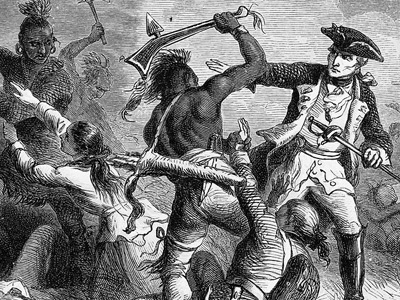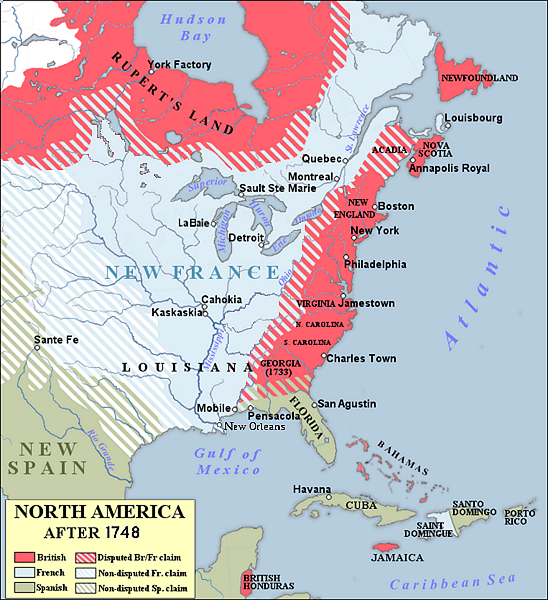French and Indian War (1754–1763)
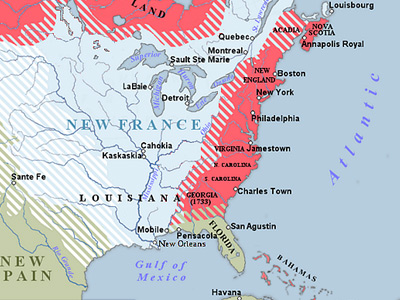
British Campaigns 1755
The British formed an aggressive plan of operations for 1755. General Braddock was to lead the expedition to Fort Duquesne. While the Massachusetts provincial governor William Shirley was given the task of fortifying Fort Oswego and attacking Fort Niagara, Sir William Johnson was to capture Fort St. Frédéric (at present-day Crown Point, New York). Lieutenant Colonel Robert Monckton was to capture Fort Beauséjour to the east, on the frontier between Nova Scotia and Acadia.
Braddock (with George Washington as one of his aides) led about 1,500 army troops and provincial militia on an expedition in June 1755 to take Fort Duquesne. The expedition was a disaster. It was attacked by French soldiers and Indian warriors ambushing them from up in trees and behind logs. Braddock called for a retreat. He was killed. Approximately 1,000 British soldiers were killed or injured. The remaining 500 British troops, led by George Washington, retreated to Virginia. Two future opponents in the American Revolutionary War, Washington and Thomas Gage, played key roles in organizing the retreat.
The French The Kingdom of France is the historiographical name or umbrella term given to various political entities of France in the medieval and early modern period. It was one of the most powerful states in Europe since the High Middle Ages. It was also an early colonial power, with possessions around the world. Colonial conflicts with Great Britain led to the loss of much of its North American holdings by 1763. The Kingdom of France adopted a written constitution in 1791, but the Kingdom was abolished a year later and replaced with the First French Republic. acquired a copy of the British
The Kingdom of France is the historiographical name or umbrella term given to various political entities of France in the medieval and early modern period. It was one of the most powerful states in Europe since the High Middle Ages. It was also an early colonial power, with possessions around the world. Colonial conflicts with Great Britain led to the loss of much of its North American holdings by 1763. The Kingdom of France adopted a written constitution in 1791, but the Kingdom was abolished a year later and replaced with the First French Republic. acquired a copy of the British The Kingdom of Great Britain was a sovereign country in Western Europe from 1 May 1707 to the end of 31 December 1800. The state was created by the 1706 Treaty of Union and ratified by the Acts of Union 1707, which united the kingdoms of England (which included Wales) and Scotland to form a single kingdom encompassing the whole island of Great Britain and its outlying islands, with the exception of the Isle of Man and the Channel Islands. war plans, including the activities of Shirley and Johnson. Shirley's efforts to fortify Oswego were bogged down in logistical difficulties, exacerbated by Shirley's inexperience in managing large expeditions. In conjunction, Shirley was made aware that the French were massing for an attack on Fort Oswego in his absence when he planned to attack Fort Niagara. As a response, Shirley left garrisons at Oswego, Fort Bull, and Fort Williams (the latter two located on the Oneida Carry between the Mohawk River and Wood Creek at present-day Rome, New York). Supplies for use in the projected attack on Niagara were cached at Fort Bull.
The Kingdom of Great Britain was a sovereign country in Western Europe from 1 May 1707 to the end of 31 December 1800. The state was created by the 1706 Treaty of Union and ratified by the Acts of Union 1707, which united the kingdoms of England (which included Wales) and Scotland to form a single kingdom encompassing the whole island of Great Britain and its outlying islands, with the exception of the Isle of Man and the Channel Islands. war plans, including the activities of Shirley and Johnson. Shirley's efforts to fortify Oswego were bogged down in logistical difficulties, exacerbated by Shirley's inexperience in managing large expeditions. In conjunction, Shirley was made aware that the French were massing for an attack on Fort Oswego in his absence when he planned to attack Fort Niagara. As a response, Shirley left garrisons at Oswego, Fort Bull, and Fort Williams (the latter two located on the Oneida Carry between the Mohawk River and Wood Creek at present-day Rome, New York). Supplies for use in the projected attack on Niagara were cached at Fort Bull.
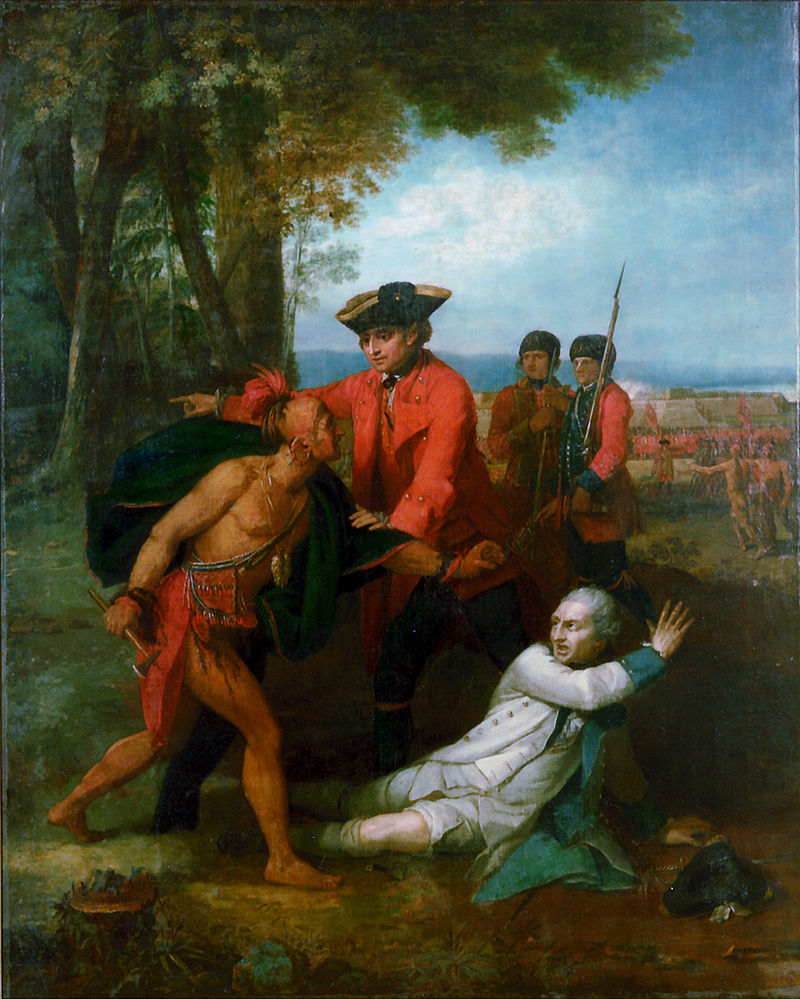
Depicts William Johnson saving the life of Baron Dieskau at the Battle of Lake George, 1755
Johnson's expedition was better organized than Shirley's, which was noticed by New France's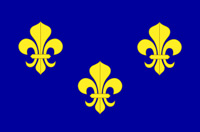 New France was the territory colonized by France in North America, beginning with the exploration of the Gulf of Saint Lawrence by Jacques Cartier in 1534 and ending with the cession of New France to Great Britain and Spain in 1763 under the Treaty of Paris. In the 16th century, the lands were used primarily to draw from the wealth of natural resources such as furs through trade with the various indigenous peoples. In the seventeenth century, successful settlements began in Acadia and in Quebec. governor, the Marquis de Vaudreuil. He had primarily been concerned about the extended supply line to the forts on the Ohio, and had sent Baron Dieskau to lead the defenses at Frontenac against Shirley's expected attack. When Johnson was seen as the larger threat, Vaudreuil sent Dieskau to Fort St. Frédéric to meet that threat. Dieskau planned to attack the British encampment at Fort Edward at the upper end of navigation on the Hudson River, but Johnson had strongly fortified it, and Dieskau's Indian support was reluctant to attack. The two forces finally met in the bloody Battle of Lake George between Fort Edward and Fort William Henry. The battle ended inconclusively, with both sides withdrawing from the field. Johnson's advance stopped at Fort William Henry, and the French withdrew to Ticonderoga Point, where they began the construction of Fort Carillon (later renamed Fort Ticonderoga after British capture in 1759).
New France was the territory colonized by France in North America, beginning with the exploration of the Gulf of Saint Lawrence by Jacques Cartier in 1534 and ending with the cession of New France to Great Britain and Spain in 1763 under the Treaty of Paris. In the 16th century, the lands were used primarily to draw from the wealth of natural resources such as furs through trade with the various indigenous peoples. In the seventeenth century, successful settlements began in Acadia and in Quebec. governor, the Marquis de Vaudreuil. He had primarily been concerned about the extended supply line to the forts on the Ohio, and had sent Baron Dieskau to lead the defenses at Frontenac against Shirley's expected attack. When Johnson was seen as the larger threat, Vaudreuil sent Dieskau to Fort St. Frédéric to meet that threat. Dieskau planned to attack the British encampment at Fort Edward at the upper end of navigation on the Hudson River, but Johnson had strongly fortified it, and Dieskau's Indian support was reluctant to attack. The two forces finally met in the bloody Battle of Lake George between Fort Edward and Fort William Henry. The battle ended inconclusively, with both sides withdrawing from the field. Johnson's advance stopped at Fort William Henry, and the French withdrew to Ticonderoga Point, where they began the construction of Fort Carillon (later renamed Fort Ticonderoga after British capture in 1759).
Colonel Monckton, in the sole British success that year, captured Fort Beauséjour in June 1755, cutting the French fortress at Louisbourg off from land-based reinforcements. To cut vital supplies to Louisbourg, Nova Scotia's Governor Charles Lawrence ordered the deportation of the French-speaking Acadian population from the area. Monckton's forces, including companies of Rogers' Rangers, forcibly removed thousands of Acadians, chasing down many who resisted, and sometimes committing atrocities. More than any other factor, the cutting off of supplies to Louisbourg led to its demise. The Acadian resistance, in concert with native allies, including the Mi'kmaq, was sometimes quite stiff, with ongoing frontier raids (against Dartmouth and Lunenburg among others). Other than the campaigns to expel the Acadians (ranging around the Bay of Fundy, on the Petitcodiac and St. John rivers, and Île Saint-Jean), the only clashes of any size were at Petitcodiac in 1755 and at Bloody Creek near Annapolis Royal in 1757.
HISTORY
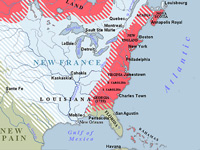
RESOURCES
This article uses material from the Wikipedia article "French and Indian War", which is released under the Creative Commons Attribution-Share-Alike License 3.0.
© Stories Preschool. All Rights Reserved.
